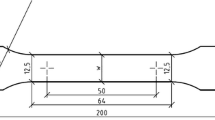Abstract
The linear unfolding inverse finite element method (IFEM) has been modified and enhanced by implementing large deformation relations. The method is helpful to predict forming severity of the part that should be deep drawn as well as its blank shape and strain distribution in preliminary design stage. The approach deals with minimization of potential energy and large deformation relations with membrane elements. To reduce the computation time, the part is unfolded properly on the flat sheet and treated as 2D problem. Moreover, the nonlinear stress-strain relationship of plastic material properties has been considered to increase the accuracy of the results. An experiment set up has been prepared to form a rectangular cup. Then, the obtained cup has been analyzed by linear unfolding IFEM and the proposed method. Comparisons of the measured thickness strains and the blank shape show that the proposed method predicts the strain distribution more accurately than the linear method.
Similar content being viewed by others
References
Chamekh A, BenRhaiem S, Khaterchi H, BelHadjSalah H, Hambli R (2010) An optimization strategy based on a metamodel applied for the prediction of the initial blank shape in a deep drawing process. Int J Adv Manuf Technol 50:93–100
Park CS, Ku TW, Kang BS, Hwang SM (2004) Process design and blank modification in the multistage rectangular deep drawing of an extreme aspect ratio. J Mater Process Technol 778–784
Azizi R, Assempour A (2008) Application of linear inverse finite element method in prediction of the optimum blank in sheet metal forming. J Mater Des 29:1965–1972
Majlessi SA, Lee D (1993) Deep drawing of square-shaped, sheet metal parts, Part1. FEM Trans ASME 115:102–109
Majlessi SA, Lee D (1987) Further development of sheet metal forming analysis method. Trans ASME 109:330–337
Batoz JL, Guo Y, Mercier F (1998) The inverse approach with simple triangular shell elements for large strain predictions of sheet metal forming parts. Eng Comput 15:864–892
Guo YQ, Batoz JL (2000) Recent developments on the analysis and optimum design of sheet metal forming parts using a simplified inverse approach. Comput Struct 78:133–148
Lee CH, Huh H (1998) Blank design and strain estimates for sheet metal forming processes by a finite element inverse approach with initial guess of linear deformation. J Mater Process Technol 82:145–155
Habibi Parsa M, Pournia P (2007) Optimization of initial blank shape predicted based on inverse finite element method. Finite Elem Anal Des 43:218–233
Liu SD, Karima M (1992) A one step finite element approach for production design of sheet metal stamping. In: Chenot JL, Wood RD, Zienkiewicz OC (eds) NUMIFORM 92, Valbonne, France. A.A. Balkema, Rotterdam, pp 497–502
Azizi R (2009) Different implementations of inverse finite element method in sheet metal forming. Mater Des 30:2975–2980
Bostan shirin M, Assempour A (2013) A new mapping technique to consider intermediate stages in multistep deep drawing. J Mech Eng Part C. doi:10.1177/0954406213509614
Kankarani FM, Bostan shirin M, Assempour A (2014) Development of an inverse finite element method with an initial guess of linear unfolding. Finite Elem Anal Des 79:1–8
Lijun F, Dong X, Wang P (2009) Study on one-step simulation for the bending process of extruded profiles. Int J Adv Manuf Technol 43:1069–1080
Lijun F, Dong X, Peng F, Wang P (2011) A generally suited method to get initial guess solutions for one-step and multi-step simulations of tube and profile forming based on parameterization. Int J Numer Methods Biomed Engng 27:1622–1639
Einolghozati M, Bostan Shirin M, Assempour A (2013) Application of inverse finite element method in tube hydro forming modeling. J Appl Math Model 37:5913–5926
Kobayashi S, Ohoh S, Altan T (1989) Metal forming and the finite element method. Oxford University Press, Oxford
Yang WY, Cao W, Chung TS, Morris J (2005) Applied numerical methods using MATLAB. John Wiley & Sons, pp: 190-195
Sowerby R, Chu E, Duncan JL (1982) Determination of large strains in metal forming. J Strain Anal 17(2):905–101
Standard test methods for tension testing of metallic materials. E 8 M, Annual Book of ASTM Standards, Vol. 03.01., ASTM
Author information
Authors and Affiliations
Corresponding author
Rights and permissions
About this article
Cite this article
Bostan Shirin, M., Assempour, A. Some improvements on the unfolding inverse finite element method for simulation of deep drawing process. Int J Adv Manuf Technol 72, 447–456 (2014). https://doi.org/10.1007/s00170-014-5663-4
Received:
Accepted:
Published:
Issue Date:
DOI: https://doi.org/10.1007/s00170-014-5663-4




